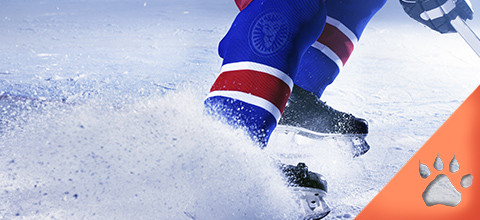
Mouthguards in NHL
The NHL is a fast-paced game, with big hits, masses of skill and great performances from the players. The thrills, the excitement and the pace keeps fans hooked, but there are risks out there on the ice.
Player protection is crucial – and this goes beyond the padding that they wear. As part of preparing for their game, players are required to wear a mouthguard because not wearing one risks injury to teeth and jaw.
In this article, we will delve into the world of mouthguards in the NHL, examining their implications, efficacy in injury prevention and various types.
Table of Content:
- Are NHL Players Legally Required to Wear Mouthguards?
- Injury Prevention and Mouthguard Efficacy
- Types of Mouthguards
- Mouthguards in NHL FAQs
Are NHL Players Legally Required to Wear Mouthguards?
In the NHL, where high-speed pucks, fierce body checks and the constant battle for possession define the game, player safety is paramount. One crucial aspect of this safety is the mandatory use of mouthguards by all players. Many contact sports are the same, but the NHL has put rules in place to protect players. Part of this is to wear a mouthguard, so every player is expected to wear one. Furthermore, they all have to wear an approved dental protector, because wearing one just isn't an option.
Injury Prevention and Mouthguard Efficacy
The NHL's commitment to mandatory mouthguard usage is grounded in solid reasoning. Research and studies in the field have consistently shown the efficacy of mouthguards in injury prevention, specifically in protecting players from dental and facial injuries. When we analyze injury rates comparing players who wear mouthguards with those who don't, the contrast is indeed significant.
NHL players are overwhelmingly in favor of these protective devices, underscoring their effectiveness in shielding against potential dental and facial injuries. Legends of the game such as Alex Ovechkin and Sidney Crosby are clear proof that players support the use of mouthguards. They appreciate the importance of safety on the risk and rightly so, because nobody wants to lose teeth or have a life-changing facial injury.
The research echoes these sentiments. The puck can move at a rapid speed while stray hockey sticks and collisions can all lead to dental injuries and facial problems. Mouthguards are designed to absorb the impact before distributing the force through the mouthguard. The result is a significant reduction in the likelihood of injury, helping to bolster player safety. Furthermore, it gives players the confidence to play on the ice while being protected.
Types of Mouthguards
The good news is that there is no shortage of options when it comes to mouthguards. They are all unique and designed in different ways, so here are three types used most by players.
Stock Mouthguards
These mouthguards are the most basic and affordable option. They come pre-made and ready to use, making them a convenient choice. However, stock mouthguards often provide a generic fit and may not be as comfortable as other options. While they offer some level of protection, they may not conform perfectly to an individual's teeth and jaw.
Boil-and-Bite Mouthguards
Boil-and-Bite mouthguards offer a step up in customization compared to stock mouthguards. Players can achieve a better fit by softening the mouthguard in boiling water and then biting down on it to mold it to their teeth. This process provides a more individualized fit and improved protection. Boil-and-Bite mouthguards are favored by some NHL players who seek a balance between affordability and customization.
Custom-Fitted Mouthguards
The gold standard in mouthguard technology, custom-fitted mouthguards are precisely tailored to an individual player's teeth and jaw. Dentists or dental professionals typically create these mouthguards. Due to their tailored fit, protection is improved, comfort is enhanced and the mouthguard becomes more effective. The cost of these mouthguards is higher, but for any player, the price does not matter when compared to the impact a facial injury could have.
The choice of mouthguard often comes down to personal preference, comfort and the perceived level of protection required.
Mouthguards in NHL FAQs
Let's address some common questions regarding mouthguards in the NHL:
Are mouthguards mandatory for all NHL players?
Yes, they are. The NHL mandates the use of approved dental protectors during games and practices.
Can players choose the type of mouthguard they wear?
Yes, as each player is different, they can choose the mouthguard that they wear. From a standard boil and bite mouthguard to a custom mouthguard, they can find the right mouthguard for them based on comfort and protection.
What happens if a player refuses to wear a mouthguard?
Players are expected to wear mouthguards, so if they refuse then there are likely to be penalties. These can come in the form of fines and disciplinary action.
What mouthguards do NHL players use?
NHL players often prefer custom-fitted mouthguards due to their superior fit and comfort. However, some may opt for boil-and-bite mouthguards for a balance of protection and comfort.
Do NHL goalies wear mouthguards?
Yes, NHL goalies wear mouthguards to protect their teeth and jaws from high-speed pucks and sticks. It's an essential part of their equipment.
Learn more about NHL in our guides: